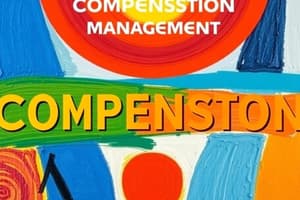Podcast
Questions and Answers
What is the main purpose of the point system in job evaluation?
What is the main purpose of the point system in job evaluation?
What are the compensable factors considered in the point system?
What are the compensable factors considered in the point system?
What does the Hay profile method evaluate?
What does the Hay profile method evaluate?
Which of the following best describes work valuation?
Which of the following best describes work valuation?
Signup and view all the answers
What is the purpose of a wage and salary survey?
What is the purpose of a wage and salary survey?
Signup and view all the answers
What are the three main components of total rewards?
What are the three main components of total rewards?
Signup and view all the answers
Which goal is NOT common in strategic compensation?
Which goal is NOT common in strategic compensation?
Signup and view all the answers
Pay Equity is primarily concerned with which concept?
Pay Equity is primarily concerned with which concept?
Signup and view all the answers
What does Expectancy Theory suggest about employee motivation?
What does Expectancy Theory suggest about employee motivation?
Signup and view all the answers
Which factor does NOT influence the setting of wages?
Which factor does NOT influence the setting of wages?
Signup and view all the answers
Which type of compensation includes retirement and insurance benefits?
Which type of compensation includes retirement and insurance benefits?
Signup and view all the answers
Why is it essential to maintain salary equity among employees?
Why is it essential to maintain salary equity among employees?
Signup and view all the answers
What is a non-financial compensation example?
What is a non-financial compensation example?
Signup and view all the answers
What does the Wage Curve represent?
What does the Wage Curve represent?
Signup and view all the answers
What are Pay Grades?
What are Pay Grades?
Signup and view all the answers
What do Red Circle Rates refer to?
What do Red Circle Rates refer to?
Signup and view all the answers
What is Broadbanding in compensation management?
What is Broadbanding in compensation management?
Signup and view all the answers
What is a primary characteristic of piecework compensation?
What is a primary characteristic of piecework compensation?
Signup and view all the answers
Which type of pay is based on an employee's variety of skills?
Which type of pay is based on an employee's variety of skills?
Signup and view all the answers
Which of the following best defines escalator clauses?
Which of the following best defines escalator clauses?
Signup and view all the answers
Which method of job evaluation is the simplest and oldest?
Which method of job evaluation is the simplest and oldest?
Signup and view all the answers
What is the primary goal of job evaluation systems?
What is the primary goal of job evaluation systems?
Signup and view all the answers
How does collective bargaining typically impact wage structures?
How does collective bargaining typically impact wage structures?
Signup and view all the answers
What defines 'real wages' in the context of wage increases?
What defines 'real wages' in the context of wage increases?
Signup and view all the answers
What is a disadvantage of the Job Ranking System?
What is a disadvantage of the Job Ranking System?
Signup and view all the answers
Which compensation structure is more appropriate for a position without specific output measurements?
Which compensation structure is more appropriate for a position without specific output measurements?
Signup and view all the answers
Flashcards
Compensation
Compensation
The total rewards given to employees, including direct (wages, salaries, bonuses) and indirect (benefits) compensation, as well as non-financial rewards.
Strategic Compensation
Strategic Compensation
Linking employee compensation to the company's goals, culture and values.
Pay Equity
Pay Equity
Employees feeling that their compensation fairly reflects the value of their work compared to others.
Expectancy Theory
Expectancy Theory
Signup and view all the flashcards
Direct Compensation
Direct Compensation
Signup and view all the flashcards
Indirect Compensation
Indirect Compensation
Signup and view all the flashcards
Total Rewards
Total Rewards
Signup and view all the flashcards
Employee Motivation
Employee Motivation
Signup and view all the flashcards
Hourly Work
Hourly Work
Signup and view all the flashcards
Piecework
Piecework
Signup and view all the flashcards
Collective Bargaining
Collective Bargaining
Signup and view all the flashcards
Real Wages
Real Wages
Signup and view all the flashcards
Consumer Price Index (CPI)
Consumer Price Index (CPI)
Signup and view all the flashcards
Job Evaluation
Job Evaluation
Signup and view all the flashcards
Job Ranking System
Job Ranking System
Signup and view all the flashcards
Job Classification System
Job Classification System
Signup and view all the flashcards
Point System Job Evaluation
Point System Job Evaluation
Signup and view all the flashcards
Work Valuation
Work Valuation
Signup and view all the flashcards
Hay Profile Method
Hay Profile Method
Signup and view all the flashcards
Wage and Salary Survey
Wage and Salary Survey
Signup and view all the flashcards
Employer-Initiated Surveys
Employer-Initiated Surveys
Signup and view all the flashcards
Wage Curve
Wage Curve
Signup and view all the flashcards
Pay Grades
Pay Grades
Signup and view all the flashcards
Rate Ranges
Rate Ranges
Signup and view all the flashcards
Red Circle Rates
Red Circle Rates
Signup and view all the flashcards
Broadbanding
Broadbanding
Signup and view all the flashcards
Study Notes
Compensation
- Compensation encompasses direct, indirect, and non-financial components.
- Direct compensation includes wages, salaries, incentives, bonuses, and commissions.
- Indirect compensation involves benefits like retirement plans, insurance, and paid time off.
- Non-financial compensation includes employee recognition, desirable jobs, positive work environments, and flexible work hours.
- Total rewards encompass all three forms of compensation, integrating career advancement, work-life balance, and job security.
Learning Objectives
- Understanding strategic compensation and its objectives.
- Exploring the link between compensation and employee motivation.
- Examining factors influencing wage setting.
- Learning how to design fair pay structures.
- Studying legal provisions affecting compensation.
What is Compensation?
- Direct compensation includes hourly wages and salaries, plus incentives, bonuses, and commissions.
- Indirect compensation consists of benefits provided by employers, like retirement, insurance, and paid time off.
- Non-financial compensation covers employee recognition, desirable work environments, flexible hours, and fulfilling job roles.
- Total rewards encompass all these components, emphasizing career advancement, work-life balance, and job security.
Strategic Compensation
- Strategic compensation aligns employee compensation with organizational mission, objectives, philosophies, and culture.
- Key goals include rewarding past performance, maintaining competitive compensation in the labor market, ensuring pay equity, linking future performance to organizational goals, controlling compensation budgets, attracting new employees, and reducing unnecessary turnover.
Motivating Employees Through Pay Equity
- Equity theory suggests that employees feel motivated when their perceived input/output ratio matches that of their peers.
- A fair compensation structure leads to feelings of equity and encourages greater work effort.
Relationship Between Equity and Motivation
- Equity theory explains how equitable compensation affects employee motivation.
- Unequal compensation leads to feelings of being underpaid or overpaid.
Motivating Employees Through Compensation: Expectancy Theory
- Expectancy theory proposes that employees will exert more effort if they believe the effort will lead to a desired reward.
- This theory emphasizes three factors: valence (the value of the reward), instrumentality (the belief that effort leads to reward), and expectancy (the conviction that effort will lead to the desired performance).
- This model prompts critical questions, including whether the task is worthwhile, whether the rewards outweigh the costs, whether the reward will be received, and whether the employee is capable of performing the required tasks.
The Bases For Compensation
- Hourly workers are compensated based on the hours worked.
- Piecework compensation is based on the number of units produced.
Determining Compensation: The Wage Mix
- Internal factors affecting compensation are organizational compensation strategy, job worth, employee worth, and employer's ability to pay.
- External factors include labor market conditions, area wage rates, cost of living, collective bargaining agreements, and legal requirements.
External Factors: Collective Bargaining
- Collective bargaining directly influences compensation through negotiations with unions.
- Compensation forms a significant component of collective bargaining agreements.
- Union agreements extend beyond the unionized segment of the labor force.
External Factors: Cost of Living and Real Wages
- Real wages consider the impact of inflation on wages.
- Consumer Price Index (CPI) measures average price changes over time.
- Escalator clauses in contracts adjust salaries to match inflation.
Internal Factors: Job Evaluation Systems
- Job evaluation is a systematic process for determining the relative worth of jobs.
- This method helps to establish internal pay equity.
Job Evaluation Systems: Job Ranking System
- A simple job evaluation technique arranging jobs based on relative worth.
- Offers a basic framework for evaluating job values.
- Less precise compared to other techniques.
Job Evaluation Systems: Job Classification System
- Jobs are classified into predetermined wage grades.
- Often used in government or public sector jobs.
- Creates manageable groups within the workforce.
Job Evaluation Systems: Point System
- A quantitative approach evaluating jobs based on points allocated to compensable factors like skills, effort, responsibility, and working conditions.
- Considered one of the most accurate evaluation methods.
- Includes a point manual describing these factors for detailed applications.
Job Evaluation Systems: Work Valuation
- A new job evaluation system focused on a job's worth to the organization.
- Emphasizes the job's contribution to financial, operational, or customer service objectives.
Job Evaluation For Management Positions: Hay Profile Method
- A technique designed specifically for evaluating executive and managerial positions.
- Focused on knowledge, mental activity, and accountability.
The Compensation Structure: Wage and Salary Survey
- Wage and salary surveys gather information about wages paid by other employers.
- Surveys help organizations establish external pay equity.
- Survey types include third-party surveys and employer-initiated ones.
Collecting Survey Data: Employer-Initiated Surveys
- Key jobs and relevant market areas are identified.
- Organizations are selected.
- Necessary wage, benefits, and policy data are collected.
- Data is compiled and analyzed to determine compensation frameworks.
The Wage Curve
- A graphical representation linking job worth and wage rates.
- Different pay grades have corresponding ranges.
- Rate ranges may be equal for each pay grade or increase.
- Red circle rates exceed the maximum of a pay range.
The Wage Curve: Broadbanding
- Combines traditional salary grades into broader bands.
- This approach helps to streamline the salary structure.
The Wage Curve: Competency-Based Pay
- Wages are determined by the skills, knowledge, and competencies of employees.
- This model encourages skill development.
Government Regulation of Compensation
- Both federal and provincial/territorial jurisdictions regulate compensation through employment standards legislation, including minimum wage, working hours, overtime pay, and paid time off.
- Canada Labour Code and specific provincial acts provide further guidelines.
Studying That Suits You
Use AI to generate personalized quizzes and flashcards to suit your learning preferences.
Related Documents
Description
This quiz explores the different components of compensation, including direct, indirect, and non-financial aspects. Participants will learn how effective compensation strategies can enhance employee motivation and job satisfaction. Additionally, the quiz covers factors influencing wage setting and the legal framework surrounding compensation.




